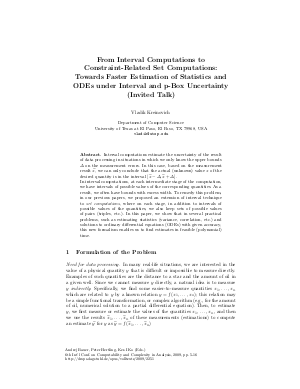From Interval Computations to Constraint-Related Set Computations: Towards Faster Estimation of Statistics and ODEs under Interval and p-Box Uncertainty (Invited Talk)
Author Vladik Kreinovich
-
Part of:
Volume:
6th International Conference on Computability and Complexity in Analysis (CCA'09) (CCA 2009)
Part of: Series: Open Access Series in Informatics (OASIcs) - License:
 Creative Commons Attribution-NonCommercial-NoDerivs 3.0 Unported license
Creative Commons Attribution-NonCommercial-NoDerivs 3.0 Unported license
- Publication Date: 2009-11-25
File

PDF
OASIcs.CCA.2009.2251.pdf
- Filesize: 309 kB
- 12 pages
Document Identifiers
Subject Classification
Keywords
- Interval computations
- set computations
- probability boxes
- uncertainty
- efficient algorithms
Metrics
- Access Statistics
-
Total Accesses (updated on a weekly basis)
0Document
0Metadata
Abstract
Interval computations estimate the uncertainty of the result of data processing in situations in which we only know the upper bounds $\Delta$ on the measurement errors. In this case, based on the measurement result $\widetilde x$, we can only conclude that the actual (unknown) value $x$ of the desired quantity is in the interval $[\widetilde x-\Delta,\widetilde x+\Delta]$.
In interval computations, at each intermediate stage of the computation, we have intervals of possible values of the corresponding quantities. As a result, we often have bounds with excess width. To remedy this problem, in our previous papers, we proposed an extension of interval technique to {\it set computations}, where on each stage, in addition to intervals of possible values of the quantities, we also keep sets of possible values of pairs (triples, etc.). In this paper, we show that in several practical problems, such as estimating statistics (variance, correlation, etc.) and solutions to ordinary differential equations (ODEs) with given accuracy, this new formalism enables us to find estimates in feasible (polynomial) time.
Cite As Get BibTex
Vladik Kreinovich. From Interval Computations to Constraint-Related Set Computations: Towards Faster Estimation of Statistics and ODEs under Interval and p-Box Uncertainty (Invited Talk). In 6th International Conference on Computability and Complexity in Analysis (CCA'09). Open Access Series in Informatics (OASIcs), Volume 11, pp. 5-16, Schloss Dagstuhl – Leibniz-Zentrum für Informatik (2009)
https://doi.org/10.4230/OASIcs.CCA.2009.2251
BibTex
@InProceedings{kreinovich:OASIcs.CCA.2009.2251,
author = {Kreinovich, Vladik},
title = {{From Interval Computations to Constraint-Related Set Computations: Towards Faster Estimation of Statistics and ODEs under Interval and p-Box Uncertainty}},
booktitle = {6th International Conference on Computability and Complexity in Analysis (CCA'09)},
pages = {5--16},
series = {Open Access Series in Informatics (OASIcs)},
ISBN = {978-3-939897-12-5},
ISSN = {2190-6807},
year = {2009},
volume = {11},
editor = {Bauer, Andrej and Hertling, Peter and Ko, Ker-I},
publisher = {Schloss Dagstuhl -- Leibniz-Zentrum f{\"u}r Informatik},
address = {Dagstuhl, Germany},
URL = {https://drops.dagstuhl.de/entities/document/10.4230/OASIcs.CCA.2009.2251},
URN = {urn:nbn:de:0030-drops-22516},
doi = {10.4230/OASIcs.CCA.2009.2251},
annote = {Keywords: Interval computations, set computations, probability boxes, uncertainty, efficient algorithms}
}
